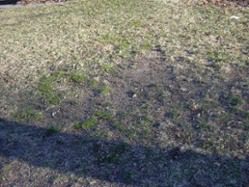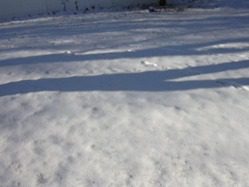Dormant Seeding
This should be a great year for dormant seeding if you already did it. We were able to do a number of lawns that needed some help, just before the recent storm. Now that seed is lying dormant under three feet of snow.

Dormant seed in a battered lawn
Here are a few pictures of dormant seeding in my backyard. This area gets trampled by kids playing, hanging around the picnic table and running to the tree house in the Norway maple. This grass has held up well over the past couple of years and I apply the dormant seed each winter to thicken and rejuvenate it. It is a bit of a gamble, but so easy it’s worth it. I just wait until a good snow storm is on the way.

A cover of snow
I prefer one of those gray days when the ground is frozen and you can almost smell the snow coming. I spread the appropriate or left over grass seed on the frozen ground and go inside to warm up and watch the snow fall. Assuming the snow stays for a while, or perhaps all winter, you will not see the seed when it melts. It has worked its way into the soil, due to the freezing and thawing and melting, and will ready to germinate in the spring when it warms up.

Spring arrives
The best time to seed is late summer or early fall, but this is a fun way to apply seed to areas that get a lot of traffic or to thicken up any lawn. With the right weather, it works great. If we have a warm spell and the seed germinates before a subsequent freeze, it doesn’t work so well. Seeds that germinate quickly, such as perennial rye have a tougher time. Research shows that February is the best time for dormant seeding and that grass plants from dormant seeds have more stored energy, more complete root systems and are better able to handle the rigors of summer than those planted in the spring.
